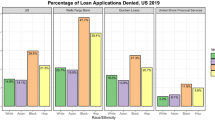Abstract
Theories of discrimination in credit markets suggest that under certain circumstances systematic lender bias may result in creditors holding minority applicants or applicants from minority neighborhoods to higher standards of creditworthiness than other borrowers. This implies lower default rates or smaller dollar losses on loans to marginally qualified minority borrowers or borrowers from minority neighborhoods, compared to loans extended to other similarly qualified borrowers. This study seeks to test this prediction by examining the default-risk characteristics of FHA-insured single-family residential mortgages. All things equal, empirical findings fail to support the theoretical predictions that observed default rates are relatively lower among minority borrowers or neighborhoods.
Similar content being viewed by others
References
Arrow, K. “The Theory of Discrimination.” InDiscrimination in Labor Markets, Ashenfelter and Rees (eds.) Princeton, New Jersey: Princeton University Press (1973).
Barth, James R., Joseph L. Cordes, and Anthony M.J. Yezer. “Financial Institution Revolutions, Redlining and Mortgage Markets.”The Regulation of Financial Institutions, Conference Series No. 21, Federal Reserve Bank of Boston, October 1979, 101–143.
Becker, Gary S.The Economics of Discrimination (2nd Edition). Chicago: University of Chicago Press (1971).
Berkovec, James, Glenn Canner, Stuart Gabriel, and Timothy Hannan. “Race and Residential Mortgage Defaults: Evidence from the FHA-Insured Single-Family Loan Program.” Conference Paper, U.S. Department of Housing and Urban Development Conference on Discrimination and Mortgage Lending, Washington, D.C. (May 1993).
Board of Governors of the Federal Reserve System. “Feasibility Study on the Application of the Testing Methodology to the Detection of Discrimination in Mortgage Lending.” Staff Analysis (June 1991).
Campbell, T., and J. Dietrich. “The Determinants of Default on Conventional Residential Mortgages.”Journal of Finance 38:5 (1983), 1569–1581.
Canner, Glenn B., and Stuart A. Gabriel. “Market Segmentation and Lender Specialization in the Primary and Secondary Mortgage Markets.”Housing Policy Debate 3:2 (1992), 241–329.
Canner, Glenn B., Stuart A. Gabriel, and J. Michael Woolley, “Race, Default Risk and Mortgage Lending: A Study of the FHA and Conventional Loan Markets.”Southern Economic Journal 58 (1991), 249–262.
Canner, Glenn B., Wayne Passmore, and Dolores S. Smith. “Residential Lending to Low-Income and Minority Families: Evidence from the 1992 HMDA Data.”Federal Reserve Bulletin 80 (February 1994), 79–108.
Clauretie, Terrance, M., and Thomas N. Herzog. “How State Laws Affect Foreclosure Costs.”Secondary Mort-gage Markets (Spring 1989), 25–28.
Evans, R.D., B.A. Maris, and R.I. Weinstein. “Expected Loss and Mortgage Default Risks.”Quarterly Journal of Business Economics 24 (1985), 75–93.
Giliberto, S.M., and A.L. Houston, “Relocation Opportunities and Mortgage Default.”AREUEA Journal 17:1 (1989), 55–69.
ICF Incorporated. “The Characteristics of HUD-Processed and Direct Endorsement Mortgages.” Prepared for the U.S. Department of Housing and Urban Development (December 18, 1989).
Kau, J., D. Keenan, and T. Kim. “Default Probabilities for Mortgages.” Department of Insurance Legal Studies and Real Estate, Terry College of Business, University of Georgia. Mimeo (1991).
Lang, William W., and Leonard J. Nakamura. “A Model of Redlining.”Journal of Urban Economics 33 (1993), 223–234.
Munnell, Alicia H., Lynn E. Browne, James McEneaney, and Geoffrey M.B. Tootell. “Mortgage Lending in Boston: Interpreting HMDA Data.” Working Paper No. 92-7, Federal Reserve Bank of Boston (October 1992).
Neal, Susan. “Review of the Mortgage Default Literature.” Housing Finance Analysis Division, U.S. Department of Housing and Urban Development, Unpublished Working Paper (December 1989).
Peterson, Richard L. “An Investigation of Sex Discrimination in Commercial Banks' Direct Consumer Lending.”The Bell Journal of Economics 12 (Autumn 1981), 547–561.
Quercia, Roberto G., and Michael A. Stegman. “Residential Mortgage Default: A Review of the Literature.”Journal of Housing Research 3:2 (1992), 341–379.
Quigley, J.M., and R. Van Order. “Defaults on Mortgage Obligations and Capital Requirements for U.S. Savings Institutions: A Policy Perspective.”Journal of Public Economics 44:3 (1991), 353–370.
Stiglitz, Joseph, and A. Weiss. “Credit Rationing in Markets with Imperfect Information.”American Economic Review (June 1981), 393–410.
Tootell, Geoffrey M.B. “Defaults, Denials, and Discrimination in Mortgage Lending.”New England Economic Review (September/October 1993), 45–51.
Turner, Margery, Michael, Fix, and Raymond Struyk.Opportunities Denied, Opportunities Diminished: Racial Discrimination in Hiring. Washington, D.C.: Urban Institute Press (1991).
Van Order, Robert, Ann-Margaret Westin, and Peter Zorn. “Effects of the Racial Composition of Neighborhoods on Default and Implications for Racial Discrimination in Mortgage Markets.” Paper presented at the ASSA meetings in Anaheim, California (January 1993).
Williamson, S., “Costly Monitoring, Financial Intermediation and Equilibrium Credit Rationing.”Journal of Monetary Economics 18 (1986), 159–179.
Yezer, A., R. Phillips, and R. Trost. “Bias in Estimates of Discrimination and Defaults in Mortgage Lending: The Effects of Screening and Self Selection.” Unpublished paper, Department of Economics, George Washington University (October 1993).
Yinger, John. “Measuring Racial Discrimination with Fair Housing Audits: Caught in the Act.”American Economic Review 76 (1986), 888–893.
Author information
Authors and Affiliations
Rights and permissions
About this article
Cite this article
Berkovec, J.A., Canner, G.B., Gabriel, S.A. et al. Race, redlining, and residential mortgage loan performance. J Real Estate Finan Econ 9, 263–294 (1994). https://doi.org/10.1007/BF01099279
Issue Date:
DOI: https://doi.org/10.1007/BF01099279



